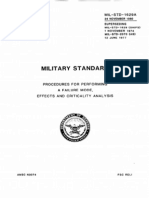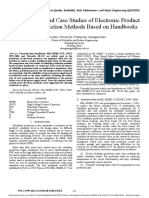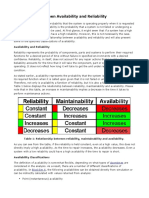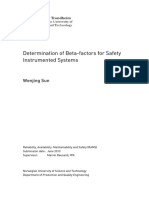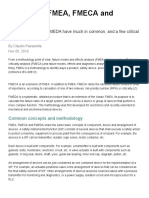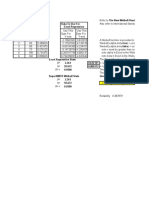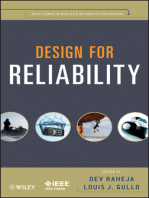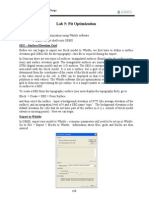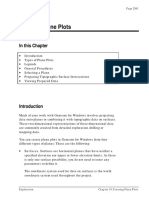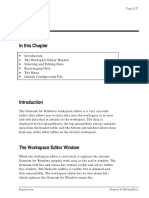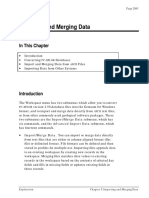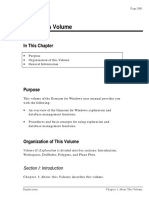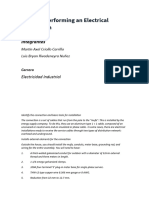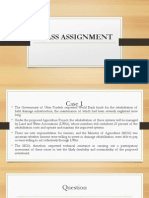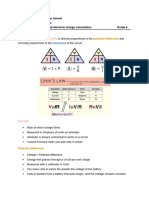Barringer Analyzer Reliability
Barringer Analyzer Reliability
Uploaded by
Tessfaye Wolde GebretsadikCopyright:
Available Formats
Barringer Analyzer Reliability
Barringer Analyzer Reliability
Uploaded by
Tessfaye Wolde GebretsadikCopyright
Available Formats
Share this document
Did you find this document useful?
Is this content inappropriate?
Copyright:
Available Formats
Barringer Analyzer Reliability
Barringer Analyzer Reliability
Uploaded by
Tessfaye Wolde GebretsadikCopyright:
Available Formats
18th International Forum for Process Analytical Chemistry
Page 1 of 9
Analyzer Reliability
Paul Barringer, P.E. Barringer & Associates, Inc. P.O. Box 3985 Humble, Texas 77347-3985, USA Phone: 1-281-852-6810 FAX: 1-281-852-3749 hpaul@barringer1.com http://www.barringer1.com
International Forum Process Analytical Chemistry January 12-15, 2004 Marriott Crystal Gateway Arlington, Virginia
Sponsored by http://www. ifpac.com IFPACfirst name in Process Analytical TechnologySM
18th International Forum for Process Analytical Chemistry
Page 2 of 9
Analyzer Reliability
Paul Barringer, P.E. Barringer & Associates, Inc.,
ABSTRACT
Fundamentals of analyzer reliability issues are discussed using failure criteria required for documenting both actual failure data and censored data. An existing data set of end user supplied information is examined using Weibull analysis which is the tool of choice for most reliability studies. Recommendations are provided for obtaining better data to enhance future Weibull analysis of analyzer data. the input to search for failure of the instrument to perform its assigned mission without touching the device. At a practical level, if the instrument requires intervention such as nursing, then a failure has occurred. By necessity, analyzers are used in a less than desirable environment (than subjected to in the laboratory or assembly area) which contributes to more frequent operational failures than occurs in the birth place of the analyzer. Likewise, analyzer(s) failure occurs if output readings between multiple instruments (or a calibration standard) vary by more than a specified amount. The inappropriate spread in variance between multiple instruments (or a standard) must be defined in operational output values, (not in % as this results in confusion for operators), and must be written down for firm criteria of failure. Failure criteria cannot be written on a rubber ruler which can be stretched and bent to meet the convenience of the moment. Analyzer life data for reliability analysis is usually highly deficient. Therefore few sound and substantial studies of analyzers, based on hard data, are available for analysis. This deficiency occurs because a firm failure criteria is not defined, age-to-failure is not acquired, different failure modes are not clearly enumerated, and censored/suspended ages are not recorded to separate failure events from age-to-failure. What reliability failure data should be gathered for a meaningful analysis? First-define a failure. Second-acquire data motivating the failure, and Third-record the exposure time Abernethy (2002) defines a clear set of three requirements for failure: the time origin must be unambiguous [i.e., where is time = 0] a scale for measuring passage of time must be set [hours, cycles, etc.] the meaning of failure must be entirely clear [written definition required] The time scale can be hours in service, cycles, shelf time, and so forth. The age of time to failure for each failure mode must be separated from failures due to events. Events resulting in failure are analyzed as suspended or censored ages.
KEYWORDS
Analyzer reliability, censored data, suspended data, failure criteria, failure data, failure modes, reliability data, reliability models, Weibull analysis.
INTRODUCTION
Reliability is the probability that a device, system, or process will perform its prescribed duty without failure for a given time when operated correctly in a specified environment. Analyzers are small systems composed of components or devices. Each of the analyzer components must function without failure (since most of the components are functionally in series) so that the production process can operate without failure. Reliability of an analyzer always terminates in a failure. In the strategy of a production operation: The production process is the king and must be preserved while pawns fail. The analyzer is a pawn. If properly configured, analyzer failure will not kill the process. The key is to preserve successful and reliable operation of the process while accepting small failures. If properly configured, analyzers are important but expendable items. However, if the analyzer is improperly configured into the system, loss of the analyzer can kill the kingly process though a fatal Achilles heel. Failure of the analyzer system must be carefully defined. Nonconformities, called failures, are easy topics for conversation but often lack clear failure definitions. Most analyzers are developed, assembled, and tested in a laboratory environment using well trained operators/assemblers who nurse the analyzer for high performance levels. A firm criterion for instrument failure at the manufacturers plant must involve subjecting the instrument to variable input as will be experienced in the production environment and measuring the deviations from
18th International Forum for Process Analytical Chemistry
Page 3 of 9
Likewise aging failures with different modes of failure also results in suspensions. The data must be carefully recorded so a meaningful reliability analysis can be performed. Unfortunately most people recording data for analyzers have never seen the results of a reliability analysis, they do not know what data is needed, and they have not seen how the data should be dissected to produce meaningful results. The simplest but crudest data analysis is conducted at the arithmetic level using mean times between failures (MTBF) for repairable components or mean times to failure (MTTF) for non-repairable components. Sometimes compromises in the data require treating all of the failures as repairable simply to drive numeric results because repairable events and non-repairable events are not carefully categorized, thus small numeric errors are acceptable simply to have some facts for giving a voice to the data. A smarter and wiser analysis uses carefully recorded data, by failure mode, for each component using Weibull analysis as described in the reference by Abernethy. Weibull analysis is the tool of choice for most reliability engineers because a single set of statistics allows components to fail by infant mortality, chance failure, or by wear-out failure modes by way of user-friendly reliability software, Fulton (2003). Weibull analysis has a major advantage as carefully recorded data, by failure mode, can tell you how the item failed (as opposed to using opinions to define how the component failed). Unfortunately many people express the opinion that components wear out when in fact, Weibull analysis may give evidence of a different failure mode, which in turn suggest a different action plan for making corrections. The follow quotation addresses analyzer unreliability: The general consensus seems to be that an experienced technician should handle from 10 to 15 analyzers., Clevett (1986). You can argue that any book about production process analyzers is immediately out of date upon publication because of the numerous changes in technology and procedures. Thus Clevetts statement may not fit your situation. However, you will always require more analyzer support than your financial systems allow in your budget. Analyzer support is driven by unreliability of both the instrument and analyzer systems as they require considerable nursing for satisfactory operation in a production plant. The number of analyzer failures and repair times can be calculated from reliability data. Today, in general, we grade hard about any type of failure (corrective maintenance as well as preventative or predictive maintenance) as we are confined to a limited workforce, and a general intolerance to disruptions for any reason. For example, today, we will not tolerate the fiddling required for a 1960s television receiver with its many problems and short life. Today we expect our television receivers to be failure free (and adjustment
free) for a period of 7 to 10 years. The change in TV failures has resulted in the demise of a trade called television repairman to a point it is a boutique business rather than a major occupation. Today, television receivers have reduced failures and longer life by use of new technology, solid state electronics, self correcting diagnosis, feedback systems, and highly redundant systems driven by a consumer who has zero tolerance for failures of any type. Financial pressure by analyzer end-users is pressing for a failure free environment. End-users need to provide objective evidence to the manufactures in a common dialog that is understandable to both manufactures and end-users. End-users and manufactures need a common dialog based on reliability data so the dialog is fact based rather than emotion based. The dialog also requires a clear definition of failure. Be careful with engineering definitions of failure [they tend to be self-justifying with allowance for failures] To get the definition of a failure correct, define a failure from the perspective of the investor which usually demands low cost, failure free operation for a specified interval of time so as to avoid expenditures. Also end-users need to tell analyzer manufactures their requirements in simple, declarative sentences such as: The analyzer must demonstrate an absence of failures during a 5 year mission for a reliability of 90% with an availability of 99.99% without human intervention in a production plant environment. In simplest of terms, a failure is: Loss of a function when you wanted the function. A more detailed definition of failure is: Failure is an event which renders equipment and processes as non-useful for the intended or specified purpose during a designated time interval. Failures include: Stoppage due to malfunction, Cessation of component function, Cessation of meeting predetermined quality, quantity, or cost expectations, An unexpected occurrence that interrupts routine operation of a system, In some cases, any human intervention required for any reason including cleaning, adjustments, or calibration. Analyzer failure codes need to be established and age-tofailure data acquired to measure reliability results so that the common dialog between manufactures and end-users can occur regarding the facts rather than having a screaming match. Another misconception between suppliers and end-users often exist over the use of terms such as availability and reliability OConnor (2003). Availability and reliability terms are different. If you dont get the language correct, youll never work on the correct problems. Availability measures the percent of time the system is alive, well, and capable of performing the assigned task. Availability for
18th International Forum for Process Analytical Chemistry
Page 4 of 9
most industries has a denominator which sums to 8760 hours/year:
Uptime Availability = Total _ Time = Uptime (Uptime+ Downtime+ PM _ Lost _ Time)
Perfect reliability only exists in your fantasy world! In the real world, high reliability is never 1.0 but always quantified with a string of point 9s (this requires use of more significant digits than learned at the university). Reliability issues and programs have some similarities with safety programs. Safety programs today are dedicated to zero accidents (failures) as addressed in our safety policies. Safety issues involve human learning and corrective action to prevent accidents called failures. Safety involves a mixture of altruism and money. In a similar fashion, reliability issues plan for zero failures, where reliability issues involve entropy deterioration often caused by aging effects with substantial influence by humans on reliability of the system. Reliability involves money and alternatives for how to accomplish the task for the lowest long term cost of ownership. Overall, safety and reliability programs are dedicated toward an absence of failures, and how humans interface with the system has direct impacts on reliability. For example ASME (2002): For 10 years, from 1992-2001, 127 people died from boiler and pressure vessel accidents and 720 people were injured. In the 23,338 accident reports, 83% were a direct result of human oversight or lack of knowledge. The same reasons were listed for 69% of the injuries and 60% of recorded deaths. In short, how humans perceive the system is vitally important to sustaining inherent reliabilityit applies to ASME Code pressure vessels just as it applies to analyzers. People influences on reliability occur from both the tactical viewpoint and the strategic viewpoint with two different technology drives. Maintenance engineers have the short range tactical viewpoint of quickly clearing failures and restoring equipment to operable conditions. Reliability engineers have a longer range strategic viewpoint of forecasting and avoiding failures. Both groups need to understand each others position and both need to also understand that their performance standards are significantly influenced by how humans interact with the equipment and how humans perceive both failures and the lack of failures as humans react to the system. Dont forget your humans when considering the reliability of analyzers: People can help/hurt the reliability results. The usual reliability question arises: Why work on reliability issues? The answer is simple: Its all about money and the tradeoffs of how/when the money is spent. So in most cases, solving a reliability problem is also solving a money problem. Reliability details tell you how often the system fails, and maintainability issues tell you how long it takes to make repairs. These two issues drive the expenditure of time, effort, and spare parts which gets you to time and money. You may think of the technical issues for analyzers, but I assure you the real issue is all about time, money, and alternatives!
Reliability measures the probability for a failure free interval. Reliability can also be an attribute measurement for a given time interval:
Re liability =
Successes Attempts
Successes ( Successes + Failures )
Reliability can also be a function of time (described here simply as an exponential distribution which is appropriate for a system but may not be appropriate for a component):
Re liability = e t = e t / = e N ,
= failure rate or = MTBF or MTTF where = 1/, t = mission time, and N = number of failures over the mission time of t Availability and reliability are both expressed in % values but they mean different things. Availability tells how you use time. Reliability tells about the probability for no failures over a given time span. For example, if your automobile has an availability of 98% for a one year interval, we can easily see that the uptime =0.98*8760 hrs = 8584.8 hrs and the downtime = (1-0.98)*8760 hrs=175.2 hrs. If the downtime occurred from one failure then the demonstrated reliability = e-1 = 36.8% which says we have a 36.8% chance of operating one year without a failure. However, if during the same number of downtime hours, you experienced three failures, then your automobile would demonstrate a miserable reliability = e-3 = 4.99% = probability of operating one year without a failure or said another way you have a 100-4.99% = 95.01% chance for failure, during the one year mission, which is a statement of unreliability defining the probability of failure. Availability tells about uptime and downtime whereas reliability tells the probability of operating the mission time without a failure. Often we speak correctly about availability and the uptime or downtime, but we fail to communicate about reliability which is driven by the number of expected failures during an interval. Reliability, as an attribute, relates the probability for success. Consider the USA space shuttle failures through the time period of February 2, 2003 with 113 success out of 115 attempts. The space shuttle has a demonstrated reliability = 113/115 = 98.26% with an unreliability = 100-98.26% = 1.74% = probability of failure for successful round trips. Reliability always terminates in a failure.
18th International Forum for Process Analytical Chemistry
Page 5 of 9
ANALYZER RELIABILITY MODELS
Nichols (1988) shows many different analyzers in a format that is adaptable to a reliability model when appropriate reliability data is employed. Most analyzer reliability models show long series strings of components. Long series strings are fraught with failure problems because failure of any item in the series model causes failure of the analyzer system. Figure 1 shows a reliability model of a typical gas chromatograph. This model and its failure rates, represents no specific instrument, but in general, it represents all gas chromatographs.
Carrier Gas Sample Injection Device Spiral Column Oven Detectors
Carrier Gas
Sample Injection Device
Spiral Column
Oven
Detectors
s=6.58E-03 failures/hr
=
Amplifiers Data Recorders Signals For Action Effluent Stream Action
System
=152 hrs/failure
Rs(t) = Ri = R1*R2*R3Rn = e-s*t
i=1
i=n
s = 1+2+3n
The probability of operating for one week without failure is: R=e-(6.58E-03)*168 = e-1.1054 = 33.107%, or p.o.f UR = 1 R = 66.893%
Figure 2: Gas Chromatograph Reliability For A One Year Mission Failure costs are shown in Table 2.
H I J K L Numbers Driven By Reliability & Maintainability Annual Repair Time Labor + Materials/ Expense Repair Annual Cost $/yr 12.50 1216.67 2607.14 620.00 4258.33 166.67 1460.00 150.00 140.00 10,631.31 M Annual Failures Pareto Rank For Corrective Action Do Later Do Later 2 Do Later 1 Do Later 3 Do Later Do Later
=
Amplifiers Recorders Signal For Action Effluent Stream Action
System
Figure 1: Gas Chromatograph Reliability Model The assumptions for expected failure rates and repair times for figure 1 are listed in Table 1.
A B C D Given From Failure Data Base MTBF Units Failure Rate E F G
Item
Mean Time Between Failure
Mean Time Labor + To Repair Expense $/hr 50.00 50.00 50.00 50.00 50.00 50.00 50.00 50.00 50.00
Materials/ Repair $/failure 100.00 5.00 1000.00 5000.00 200.00 500.00 500.00 200.00 300.00
failures/hr hrs/failure Carrier Gas 12 Sample Injection Device 9 Spiral Column 26 Oven 10 Detectors 30 Amplifiers 6 Data Recorders 25 Signals For Action 4 Effluent Stream Action 5 Overall System--> 152.0 A, B, C, E, F, G = Given D = 1/B corrected for hours yrs/failure days/failure wks/failure yrs/failure days/failure yrs/failure wks/failure yrs/failure yrs/failure hrs/failure 9.51E-06 4.63E-03 2.29E-04 1.14E-05 1.39E-03 1.90E-05 2.38E-04 2.85E-05 2.28E-05 6.58E-03 1.0 0.5 6.0 24.0 3.0 10.0 4.0 8.0 8.0 1.474
failures/yr hrs/yr $/yr $/yr Carrier Gas 0.083 0.083 4.17 8.33 Sample Injection Device 40.556 20.278 1013.89 202.78 Spiral Column 2.005 12.033 601.65 2005.49 Oven 0.100 2.400 120.00 500.00 Detectors 12.167 36.500 1825.00 2433.33 Amplifiers 0.167 1.667 83.33 83.33 Data Recorders 2.086 8.343 417.14 1042.86 Signals For Action 0.250 2.000 100.00 50.00 Effluent Stream Action 0.200 1.600 80.00 60.00 Overall System--> 57.613 84.904 4,245.18 6,386.13 H = D*8760hrs/yr I = H*E J = F*I K = H*G L=J+K M = Separates the vital few $ issues in column L from the trivial many
Fai T lur ime es
Mo ne
Table 2: Analyzer Failure Costs From Figure 1 Driven By Table 1 And Figure 2 Appropriate production losses due to instrument failures must be included and likewise damage to the process from absence of the analyzer, however, they are not included for this particular simple case in Table 2. Notice the action list in Table 2 is based on lost money and not the incidence of failures. To achieve better analyzer performance without affecting the production system, two or more instruments (and/or redundancy of high failure rate components) may be required to permit survival without individual analyzers compromising the production system integrity. Simultaneous operation of four analyzers (where only 1 analyzer must survive for success) is described in Figure 3. Of course four simultaneous instruments require larger capital investments and larger maintenance costs for sustaining the analyzers to achieve the greater reliability and consequently lower system failure rates. The RAPTOR model used the string of individual blocks from Figure 1 along with the data shown in Table 1 for the Monte Carlo simulation symbolized in each of the small system single blocks in Figure 3.
Availability = MTBF/(MTBF+MTTR) = 99.04%
Table 1: Failure Rates & Repair Times For Gas Chromatograph Reliability Model In Table 1, availability is high (99.04%) as the failed system is quickly restored to service. Reliability is low (R=33.107%) even for a very short, one week, mission time because of frequent failures (MTBF = 152 hours/failure) with quick repairs (MTTR = 1.474 hours). The most failure prone devices (i.e., highest failure rates) in Figure 1 and Table 2 lack redundancy. They are Achilles heels for analyzer reliability and should be candidates for improvement or redundancy to reduce analyzer system failures. Figure 2 shows details of the reliability model. If figure 2 is measured on a mission time of one month, or one year, or a five year basis, the reliability values can be miniscule because of the high failure rates for the system.
18th International Forum for Process Analytical Chemistry
Page 6 of 9
Figure 3: Reliability of M Out Of N System
s=6.58E-03 failures/hr
System
s=6.58E-03 failures/hr
System
s< 6E-07 failures/hr which is ~ 1 failure out of 10,000 weeks of use
the numbers shown in Figure 3. Many replications are required because the use of random numbers results in a different outcome from each simulation. From the noise of the individual simulations comes a clear signal for expected performance during a Monte Carlo simulation. The number of simultaneous analyzers employed in operation depends upon instrument failure rates, repair rates, consequence of failures, and capital investment. Thus the entire issue is typical of most reliability problems: it is all about time and money which is driven by technical facts to make decisions.
=
1 of 4
System
s=6.58E-03 failures/hr
System
> 1,680,000 hrs/failure
s=6.58E-03 failures/hr
System
Use no-cost RAPTOR software (see http://www.barringer1.com) to find complicated system reliability
The system R =0.9999 with 3.66% of the time the system is operating with three out of the four devices failed at the same time and the system is down 0.000006% of the time.
WEIBULL FAILURE DETAILS
An end-user presented oxygen analyzer failure data for review of failures. The data had 11 failure modes from would not span to cell dead. See Table 3 for the raw data.
16 17 18 19 20 21 22 23 24 cell cell 25 26 27 28 29 30 31
The model was run for a one week interval and the simulation was repeated 10,000 times to produce oduce
Instrument--> Date 10/12/2001 10/14/2001 10/23/2001 11/6/2001 1/22/2002 2/8/2002 3/4/2002 3/25/2002 4/2/2002 4/22/2002 5/1/2002 5/9/2002 5/20/2002 5/30/2002 6/8/2002 6/16/2002 6/17/2002 7/21/2002 8/9/2002 8/12/2002 8/19/2002 9/6/2002 9/26/2002 9/29/2002 10/7/2002 10/13/2002 10/14/2002 10/27/2002 11/6/2002 11/12/2002 11/19/2002 11/26/2002 11/27/2002 11/29/2002 12/1/2002 12/3/2002 12/31/2002 2/6/2003 2/25/2003 3/25/2003 3/27/2003 4/21/2003 4/22/2003 4/24/2003 5/17/2003 5/21/2003 6/9/2003 7/14/2003 7/27/2003 8/5/2003 8/7/2003 8/8/2003 8/11/2003 8/16/2003 8/23/2003 8/26/2003 9/8/2003 9/11/2003 9/30/2003 10/1/2003 10/12/2003 10/19/2003 Cum Days 737 Days/failure 4 184 1 2 3 4 5 6 7 8 9 10 11 12 13 14 15
349 days suspension
cell
304 days age-to-failure
cell
cell cell
cell cell cell cell cell cell cell cell cell cell cell cell cell cell cell cell cell cell cell
cell cell cell cell cell cell cell cell cell cell cell cell liquid liquid wont span not cell - wiring liquid new analyzer cell new cell chang'd with electronics wont span v. slow failing (diag) cell cell wont span drifting cell cell wont span cell wont span cell cell cell slow slow dead dead "bad" slow slow cont. drift dead wont span cell dead Cum Failures 2 369 5 147 5 147 4 184 6 123 2 369 3 246 2 369 4 184 3 246 2 369 1 737 4 184 3 246 3 0 6 246 >737 123 2 369 3 246 2 369 2 369 2 369 2 0 0 2 369 >737 >737 369 2 369 1 737 2 369 Total 1 80 737 285.6 Average Failures 2.581 cell cell cell cell cell cell cell cell
Table 3: Raw Data For Oxygen Detectors In Similar Service
18th International Forum for Process Analytical Chemistry
Page 7 of 9
This specific life analysis was for a failure mode of cell. This failure mode occurs when chemicals in the cell were depleted and would no longer function. All other 10 reasons for failures and the cells that still had remaining life were considered suspensions. Data from Table 3 has been converted to age-to-failure data in Table 4 along with the suspensions. Furthermore, the data with suspensions of life greater than 180 days and actual reported life greater than 180 days were considered incorrect reports because data was missing from Table 3.
The data older than 180 days was not used because of reporting errors. Reliability data must be carefully accumulated using consistent failure criteria and age-to-failure data along with suspended ages which are carefully recorded. Each failure mode must be analyzed separately. See Table 5 for failure data used for the Weibull plot. Suspension (unfailed age, and failure from different failure modes) carry the label of a - sign. Age-to-failure is shown with positive numbers.
Instrument--> Date 10/12/2001 10/14/2001 10/23/2001 11/6/2001 1/22/2002 2/8/2002 3/4/2002 3/25/2002 4/2/2002 4/22/2002 5/1/2002 5/9/2002 5/20/2002 5/30/2002 6/8/2002 6/16/2002 6/17/2002 7/21/2002 8/9/2002 8/12/2002 8/19/2002 9/6/2002 9/26/2002 9/29/2002 10/7/2002 10/13/2002 10/14/2002 10/27/2002 11/6/2002 11/12/2002 11/19/2002 11/26/2002 11/27/2002 11/29/2002 12/1/2002 12/3/2002 12/31/2002 2/6/2003 2/25/2003 3/25/2003 3/27/2003 4/21/2003 4/22/2003 4/24/2003 5/17/2003 5/21/2003 6/9/2003 7/14/2003 7/27/2003 8/5/2003 8/7/2003 8/8/2003 8/11/2003 8/16/2003 8/23/2003 8/26/2003 9/8/2003 9/11/2003 9/30/2003 10/1/2003 10/12/2003 10/19/2003
10
11
12
13
14
15
16
17
18
19
20
21
22
23
24
25
26
27
28
29
30
31
-2 -11 -25 102 -119 -143 -164 -164 -172 -172 -192 -201 37 56 -220 19 27 76 90 -301 304 -311 72 -329 -349 209 -367 147 -380 -390 294 -173 -7 -292 165 -5 -417 134 -65 -292 -365 -339 189 -545 275 -25 -30 225 227 -97 247 -108 -665 137 114 -179 -40 -683 -16 -94 -162 -65 -1 -155 -208 -19 -18 -57 -417 162 -41 -180 -18 -292 -377 -38 -151 -347 -73 -517 -69 -737 -75 -320 -385 401 -7 -371 -64 -433 -737 -737 -326 -341 -54 -19 -72 197 356 -559 -556 309 49 17 -220 28 228 167 -192
Table 4: Age-To-Failure For Cell Failures Where - Signifies Suspended Data
18th International Forum for Process Analytical Chemistry
Page 8 of 9
Most of the data for Table 5 contains censored information from unfailed units or units that have failed with a different failure mode. This complexity is a common occurrence for reliability data. If the suspensions are not recorded correctly, then the answers from the Weibull analysis will be incorrect! Table 5: Cell Data For Weibull Analysis
Cell Failures Suspensions Suspensions Failures -180 -64 17 -179 -57 19 -173 -54 27 -172 -41 28 -172 -40 37 -164 -38 49 -164 -30 56 -162 -25 72 -155 -25 76 -151 -19 90 -143 -19 102 -119 -18 114 -108 -18 134 -97 -16 137 -94 -11 147 -75 -7 162 -73 -7 165 -72 -5 167 -69 -2 -65 -1 -65
Of course, the plot in Figure 4 says 43% of the life data will be greater than 180 days, 10% of the data can live longer than 350 days, and 1% of the data can survive longer than 555 days. If we include old data and old suspensions in the data set, the Weibull failure mode is still wear out, beta = 1.28, and the characteristic life, eta = 469.1 days. Which analysis is correct?the issue can be argued, however, better data recording of ages and suspensions for a given failure mode can answer the question to avoid arguments. Why is it important to quantify failures by Weibull analysis? Use the Weibull characteristics of failure to improve accuracy of the reliability model. Because we have a wear out failure mode we can now use the Weibull information to aid in replacement decisions based on the cost for a planned replacement and unplanned replacement. Suppose the cost for a planned replacement is $2000 and the total cost for an unplanned replacement is $8000. Using the Weibull results, we can find the optimum replacement interval where cost is the least is 167 days as shown in Figure 5.
Remember data for Table 5 is truncated. The truncation is based on engineering judgment that any calculated age of a failure or a suspension greater than 180 days only occurred because data was missing from the tabulation. Table 5 is used to make the probability plot in Figure 4.
Figure 4 shows the Weibull probability plot obtained by use of WinSMITH Weibull software (Fulton 2003) on the data in Table 5. The single point estimate of cell life given by the eta value is 201 days. The beta value on the Weibull plot is > 1 which tells the failure mode is wearout which is in concert with the end users perception that the cell mode of failure should be a physical wear out phenomena. In Figure 4, the goodness of fit criteria is r2, the coefficient of determination, and it exceeds the critical value which shows the curve fit is valid at 90% confidence. The symbols n/s says the data set has 59 data points of which 41 are suspensions.
Figure 5: Optimum Replacement Interval = 167 days Note the sensitivity of the cost versus time curve in Figure 5 which suggests a small gain by use of optimum replacement. However, and a more practical strategy would simply be to run to failureparticularly in light of the possibility that the detectors may demonstrate life longer than 180 days. As another case, if the unplanned costs were only $6000, no optimum replacement exists. Figure 5 helps reduce arguments and wasted time by endless discussions about the most effective replacement strategies. The curve in Figure 5 was made using WinSMITH Visual software Fulton (2003).
Figure 4: Weibull Probability Plot
18th International Forum for Process Analytical Chemistry
Page 9 of 9
SUMMARY
Reliability models can be used to predict the failures expected and the maintenance demands for sustaining resources along with the decision making process for the quantity of instruments needed to make life cycle cost decisions. The decisions can be fact based using reliability data. When failure data is analyzed using reliability technology, life of components can be quantified along with failure modes such as infant mortality, chance failures, and wear out failure modes. When the failure modes and Weibull life are connected with planned/unplanned costs, better maintenance decisions can be implemented based on facts rather than endless arguments about the right strategy to be employed for cost effective maintenance decisions.
Professional Engineer in Texas. His education includes a MS and BS in Mechanical Engineering from North Carolina State University, and he participated in Harvard University's three week Manufacturing Strategy conference. Other details and technical papers on a variety of reliability and life cycle cost issues are available at http://www.barringer1.com for other background details or send e-mail to hpaul@barringer1.com. December 2, 2003 Barringer & Associates, Inc. 2003
REFERENCES
Abernethy, Robert B, The New Weibull Handbook, 4th edition, published by the author, North Palm Beach, FL, (2002) ASME National Board Bulletin, Ten Years Of Incident Reports Underscore Human Errors As Primary Cause Of Accidents, Summer 2002, Volume 57, Number 2, page 10, (2002) Clevett, Kenneth J., Process Analyzer Technology, John Wiley & Sons, New York, NY, (1986) Fulton, Wes, WinSMITH Weibull software, version 4.0WD, Fulton Findings, Torrence, CA, (2003) Nichols, Gary D., On-Line Process Analyzers, John Wiley & Sons, New York, NY, (1988) OConnor, Patrick D., Practical Reliability, 4th edition, John Wiley & Sons, New York, NY, (2002)
BIOGRAPHIC INFORMATION
H. Paul Barringer, P.E. Reliability, engineering, and manufacturing consultant. Author of the basic reliability training course Reliability Engineering Principles, a practical financial evaluation course Life Cycle Costs, and Process Reliability which is a high level method of assessing and understanding process reliability. More than forty years of engineering and manufacturing experience in design, production, quality, maintenance, and reliability of technical products. He is a contributor to The New Weibull Handbook, a reliability engineering text published by Dr. Robert B. Abernethy. Barringer is named as inventor in six U.S.A. Patents and numerous foreign patents. He is a licensed
You might also like
- Campimetro Octopus 101 SERNEW100Document6 pagesCampimetro Octopus 101 SERNEW100Platon Juan75% (4)
- Mil HDBK 1390 - LoraDocument31 pagesMil HDBK 1390 - Lorakaiser777No ratings yet
- Rga7 TrainingDocument123 pagesRga7 TrainingamiestudentNo ratings yet
- Mil STD 1629A PDFDocument54 pagesMil STD 1629A PDFaakashtrivedi0% (1)
- A Comparison and Case Studies of Electronic Product Reliability Prediction Methods Based On HandbooksDocument4 pagesA Comparison and Case Studies of Electronic Product Reliability Prediction Methods Based On HandbooksJulian DengNo ratings yet
- 217 PlusDocument3 pages217 PlusArunkumar SundararajanNo ratings yet
- Reliability Analysis For Repairable v1.9Document266 pagesReliability Analysis For Repairable v1.9ES Rouza100% (1)
- Mil STD 756bDocument85 pagesMil STD 756bgeoffxyz0No ratings yet
- Failure Mode Mechanism DistributionsDocument365 pagesFailure Mode Mechanism DistributionsGonzalo CN100% (1)
- Strategic Mine Planning SurpacWhittleDocument308 pagesStrategic Mine Planning SurpacWhittleTessfaye Wolde Gebretsadik91% (11)
- THE ALMATY METRO RING-RADIAL NETWORK / by G.K.SamoilovDocument157 pagesTHE ALMATY METRO RING-RADIAL NETWORK / by G.K.SamoilovGleb K.SamoilovNo ratings yet
- Theories of EntrepreneurshipDocument21 pagesTheories of EntrepreneurshipChIrag Jain100% (7)
- Reliability PredictionDocument6 pagesReliability Predictionjcmora22No ratings yet
- Reliability Data of Omron ComponentsDocument1 pageReliability Data of Omron Componentsastojadin1873No ratings yet
- Availability and ReliabilityDocument3 pagesAvailability and ReliabilityUsama SheikhNo ratings yet
- Mechanical Design Reliability Handbook Simplified ApproachDocument103 pagesMechanical Design Reliability Handbook Simplified ApproachRanjith RajendranNo ratings yet
- PERD Where For Art Thou Failure Rate Data PDFDocument10 pagesPERD Where For Art Thou Failure Rate Data PDFganeshdhageNo ratings yet
- Reliability GrowthDocument267 pagesReliability GrowthgirisanaNo ratings yet
- Beta FactorDocument89 pagesBeta Factorpaul_brightNo ratings yet
- Life Data Analysis Reference PDFDocument429 pagesLife Data Analysis Reference PDFiganu76No ratings yet
- Failure Data and RiskDocument6 pagesFailure Data and RiskmawooaNo ratings yet
- Evaluating FMEA, FMECA and FMEDADocument6 pagesEvaluating FMEA, FMECA and FMEDAZakaria RadaNo ratings yet
- A Two-Stage Failure Mode and Effect Analysis of Offshore Wind Turbines - 2020Document24 pagesA Two-Stage Failure Mode and Effect Analysis of Offshore Wind Turbines - 2020johnNo ratings yet
- Weibull Analysis in ExcelDocument7 pagesWeibull Analysis in ExcelPurwantoroNo ratings yet
- SPAR H WorksheetDocument230 pagesSPAR H WorksheetLopez RagnarNo ratings yet
- The Basic Reliability CalculationsDocument30 pagesThe Basic Reliability CalculationsAbdulyunus AmirNo ratings yet
- Failure Data - ENIDocument35 pagesFailure Data - ENIaleNo ratings yet
- Iaea Tecdoc 478Document298 pagesIaea Tecdoc 478daymonNo ratings yet
- Reliability Growth and Repairable System Analysis ReferenceDocument392 pagesReliability Growth and Repairable System Analysis Referencehelton_bsb100% (1)
- Paper 262 Statistical Methods For Reliability Data Using SASR SoftwareDocument10 pagesPaper 262 Statistical Methods For Reliability Data Using SASR Softwaredshalev8694No ratings yet
- LCAM Whitepaper 204 PDFDocument7 pagesLCAM Whitepaper 204 PDFShashank JainNo ratings yet
- PFD CalculationDocument6 pagesPFD CalculationFordNo ratings yet
- Nonelectronics Reliability DataDocument259 pagesNonelectronics Reliability Dataandy rumanjayaNo ratings yet
- Reliability PredictionDocument7 pagesReliability PredictionbederinadmlNo ratings yet
- Electricity Reliability 031611Document35 pagesElectricity Reliability 031611Nishith ShettyNo ratings yet
- MTBF Calculator (Reliability Calculation System)Document233 pagesMTBF Calculator (Reliability Calculation System)Polimore100% (1)
- List of Reliability StandardsDocument7 pagesList of Reliability Standardsmzai2003No ratings yet
- Mil HDBK 189Document155 pagesMil HDBK 189imatafernandezNo ratings yet
- As 61508.5-2011 Functional Safety of Electrical Electronic Programmable Electronic Safety-Related Systems ExaDocument10 pagesAs 61508.5-2011 Functional Safety of Electrical Electronic Programmable Electronic Safety-Related Systems ExaSAI Global - APACNo ratings yet
- Availability Simulation - IsographDocument1 pageAvailability Simulation - IsographsaospieNo ratings yet
- STF38 Reliability Data For Control and Safety Systems 1998Document47 pagesSTF38 Reliability Data For Control and Safety Systems 1998Sara ZaedNo ratings yet
- Ecss-Q-30-02A Failure Modes, Effect and Criticality Analysis (Fmeca) (7 September 2001)Document52 pagesEcss-Q-30-02A Failure Modes, Effect and Criticality Analysis (Fmeca) (7 September 2001)jgonzalezsanz8914No ratings yet
- Reliability Designof Mechanical Systemformechanicalcivil EngineerDocument435 pagesReliability Designof Mechanical Systemformechanicalcivil EngineerGestión WebNo ratings yet
- 4.5 May2019-Repairable SystemDocument10 pages4.5 May2019-Repairable SystemAlexander GejetanusNo ratings yet
- DNV RAM FPSO White PaperDocument7 pagesDNV RAM FPSO White PaperOkonji C Stephen100% (2)
- Reliability Data - ROSS - NTNUDocument3 pagesReliability Data - ROSS - NTNUSuro WijoyoNo ratings yet
- Failure and Reliability Prediction by SVMDocument8 pagesFailure and Reliability Prediction by SVMuamiranda3518No ratings yet
- Reliability and MaintenanceDocument24 pagesReliability and MaintenanceFelipe Raphaelli da SilveiraNo ratings yet
- A 278508Document127 pagesA 278508James LclNo ratings yet
- Literature Search For Reliability Data of Components in Electric Distribution NetworksDocument160 pagesLiterature Search For Reliability Data of Components in Electric Distribution Networksnaddumj100% (1)
- Mil STD 756b PDFDocument85 pagesMil STD 756b PDFOIC100% (1)
- Physics of Failure NASADocument219 pagesPhysics of Failure NASAStats Tutor100% (1)
- OEM - OSHA 2014 - Obsolescence Management For Industrial AssetsDocument24 pagesOEM - OSHA 2014 - Obsolescence Management For Industrial AssetsxtremewhizNo ratings yet
- Mil HDBK 217fDocument80 pagesMil HDBK 217fb4upalaniNo ratings yet
- Weibull7 TrainingDocument100 pagesWeibull7 TrainingPravin ShekharNo ratings yet
- 01 Functional Safety 2018.03.27Document76 pages01 Functional Safety 2018.03.27Ghassen EssidNo ratings yet
- Structured What If Technique A Complete Guide - 2020 EditionFrom EverandStructured What If Technique A Complete Guide - 2020 EditionNo ratings yet
- P B M I - Morrison Copper/Gold Project Feasibility Study Volume 4 - Operating Cost Estimate (OPEX)Document34 pagesP B M I - Morrison Copper/Gold Project Feasibility Study Volume 4 - Operating Cost Estimate (OPEX)Tessfaye Wolde GebretsadikNo ratings yet
- Gemcom Cursos Gems 6 0Document88 pagesGemcom Cursos Gems 6 0Tessfaye Wolde GebretsadikNo ratings yet
- 01 Surface Production Initialisation V70Document112 pages01 Surface Production Initialisation V70Ricardo Contreras B100% (2)
- Evaluating Tenders OffersDocument29 pagesEvaluating Tenders OffersTessfaye Wolde GebretsadikNo ratings yet
- Lab05 Pit OptimizationDocument10 pagesLab05 Pit OptimizationTessfaye Wolde Gebretsadik100% (1)
- Gemcom IntroductionDocument61 pagesGemcom IntroductionTessfaye Wolde GebretsadikNo ratings yet
- Polygons and OutlinesDocument95 pagesPolygons and OutlinesTessfaye Wolde GebretsadikNo ratings yet
- 2127 PDFDocument23 pages2127 PDFTessfaye Wolde GebretsadikNo ratings yet
- 2261 PDFDocument30 pages2261 PDFTessfaye Wolde GebretsadikNo ratings yet
- Working With DrillholesDocument87 pagesWorking With DrillholesTessfaye Wolde Gebretsadik100% (1)
- Analisis SemivariogramasDocument32 pagesAnalisis SemivariogramasJavier Carrasco CarhuatoctoNo ratings yet
- The Gemcom For Windows Workspace: SubdirectoriesDocument63 pagesThe Gemcom For Windows Workspace: SubdirectoriesTessfaye Wolde GebretsadikNo ratings yet
- Importing and Merging Data: PC Xplor AsciiDocument43 pagesImporting and Merging Data: PC Xplor AsciiTessfaye Wolde GebretsadikNo ratings yet
- Extracting Data: PC MineDocument109 pagesExtracting Data: PC MineTessfaye Wolde GebretsadikNo ratings yet
- Strategic Open Pit Mine Planning Course PDFDocument1,009 pagesStrategic Open Pit Mine Planning Course PDFAnonymous IabqZQ1tk100% (1)
- Lossan 43 101 Technical ReportDocument295 pagesLossan 43 101 Technical ReportTessfaye Wolde GebretsadikNo ratings yet
- About This Volume: Section I: IntroductionDocument18 pagesAbout This Volume: Section I: IntroductionTessfaye Wolde GebretsadikNo ratings yet
- Diamec DrillrigsDocument4 pagesDiamec DrillrigsTessfaye Wolde GebretsadikNo ratings yet
- GEMS62 TunnelDesignDocument17 pagesGEMS62 TunnelDesignTessfaye Wolde GebretsadikNo ratings yet
- Gems Release NotesDocument8 pagesGems Release NotesTessfaye Wolde GebretsadikNo ratings yet
- 2001 - Open Pit Geotechanical DescriptionDocument18 pages2001 - Open Pit Geotechanical DescriptionTessfaye Wolde GebretsadikNo ratings yet
- Strategic Open Pit Mine Planning Course PDFDocument1,009 pagesStrategic Open Pit Mine Planning Course PDFAnonymous IabqZQ1tk100% (1)
- GEMS Block Modelling LABSDocument70 pagesGEMS Block Modelling LABSTessfaye Wolde GebretsadikNo ratings yet
- An Handling ProcedureDocument1 pageAn Handling ProcedureTessfaye Wolde GebretsadikNo ratings yet
- GEMS Geostats Labs1 BasicsDocument22 pagesGEMS Geostats Labs1 BasicsTessfaye Wolde Gebretsadik50% (2)
- Design and Evaluation of Tailings DamsDocument57 pagesDesign and Evaluation of Tailings DamsTessfaye Wolde Gebretsadik100% (1)
- ORAT BrochureDocument16 pagesORAT Brochurenevodien100% (1)
- Convert TDMSDocument7 pagesConvert TDMSBhanupriya JainNo ratings yet
- Lexmark Key Code ListDocument11 pagesLexmark Key Code ListCarlos Sánchez GallardoNo ratings yet
- Ingles Guía para Realizar Una Instalación EléctricaDocument7 pagesIngles Guía para Realizar Una Instalación EléctricaMauricio Criollo CarrilloNo ratings yet
- URA Website Terms ConditionsDocument5 pagesURA Website Terms Conditionsjose300No ratings yet
- G8 BOW Commercial Cooking First QuarterDocument4 pagesG8 BOW Commercial Cooking First QuarterAllen Dimapilis100% (1)
- Bale PluckerDocument11 pagesBale PluckerSiva Jagadish Kumar M100% (4)
- Components Success Indicators (SI) Rating Scale/Scheme Quantity Quality TimelinessDocument2 pagesComponents Success Indicators (SI) Rating Scale/Scheme Quantity Quality TimelinessShirley Jean Villamor SuganoNo ratings yet
- Pgfplots - Tikzpicture and PDFDocument3 pagesPgfplots - Tikzpicture and PDFjhorckhamNo ratings yet
- Aim: To Evaluate A Definite Integral by Simpson's 3/8 Rule AlgorithmDocument3 pagesAim: To Evaluate A Definite Integral by Simpson's 3/8 Rule Algorithmpriyadarshini212007No ratings yet
- A Bright Idea For GEDocument3 pagesA Bright Idea For GEarshdhirNo ratings yet
- Road Safety Report-74 PagesDocument74 pagesRoad Safety Report-74 PagesMinatiBindhaniNo ratings yet
- Marketing Strategy of AirtelDocument74 pagesMarketing Strategy of AirtelPriyanka Tyagi0% (1)
- Indian Navy Result of Campus Interview Ues July 2012 Course: S.No. Roll No. Name Sex DOB Education BranchDocument4 pagesIndian Navy Result of Campus Interview Ues July 2012 Course: S.No. Roll No. Name Sex DOB Education BranchShiv MathurNo ratings yet
- Principles of Food Engineering Lecture 1Document6 pagesPrinciples of Food Engineering Lecture 1Suyash Gupta100% (1)
- SOA Principles PosterDocument1 pageSOA Principles PosterDijana BanićNo ratings yet
- Magnetic Field and Field Lines-FDocument20 pagesMagnetic Field and Field Lines-FjamaluddinNo ratings yet
- Case Studies On Participatory Rural AppraisalDocument14 pagesCase Studies On Participatory Rural AppraisalKapil SikkaNo ratings yet
- Dewey Physical Properties of Blast Waves 2016Document35 pagesDewey Physical Properties of Blast Waves 2016NgocTraiNguyenNo ratings yet
- Electrical Wire LabelingDocument2 pagesElectrical Wire LabelingAlliver SapitulaNo ratings yet
- Real Time SystemsDocument27 pagesReal Time SystemsSimmi JoshiNo ratings yet
- Electric Circuits - Ohms LawDocument11 pagesElectric Circuits - Ohms LawCarmenNo ratings yet
- Warp Stop Motions: Groz-Beckert KGDocument2 pagesWarp Stop Motions: Groz-Beckert KGAhmed IbrahimNo ratings yet
- Life Cycle Assessment of Paper BagDocument6 pagesLife Cycle Assessment of Paper BagBernie Quep67% (3)
- INTEGRATED OEM GENERAL ELASTOMER CATALOG - 1 2020bDocument45 pagesINTEGRATED OEM GENERAL ELASTOMER CATALOG - 1 2020bMehdi Soltani0% (1)
- Fermit Brochure For DealersDocument7 pagesFermit Brochure For DealersProject Sales CorpNo ratings yet
- ShotcreteDocument26 pagesShotcreteMohamed Nk100% (1)



